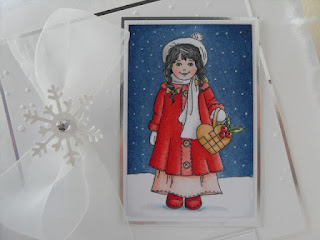| Tilda with an aura |
Teresa from Docrafts asked me how I did the glow around Tilda in my recent card for Fluffles Tilda challenge/Copic Creations challenge. It's really easy to do, and is a step up from the grey or blue shadow that we all put around our characters.
You'll need your blender pen and your chosen shade for the coloured glow. I find the paler shades easier to blend out: in the Tilda challenge card, I used YR000, and in this first example I used R00.
Basically, I add some colour around my image, then use the blender pen to fade that colour away to nothing. I work in small sections at a time (so that the ink doesn't get a chance to dry or else it won't blend out so well), starting at the lower-right or lower-left of the image, just above the ground Tilda is standing on, working up and over the image and down the other side, stopping when I get to ground level. If you start at the top, you'll get a 'join' in the ink where you began as that ink will have dried.
 |
| Blending out the R00 |
 |
| The finished image |
Another way of achieving this look, but without the fiddliness of colouring around all the nooks and crannies of the outline, is to colour the glow onto plain white paper, then colour up your stamped image, cut it out and stick onto your coloured glow background.
You don't have to do a whole aura glow, you can simply put in a fuzzy version of a shadow round your image, by just adding your grey shadow as usual, then using your blender to fade it out to nothing. This gives a nice subtle edge to your shadow around your character. Again, work in small sections at a time so that the shadow doesn't dry, or else you won't be able to blend it out very well.
 |
| B63 blended out as a shadow |
 |
| B63 used to make an aura |
This does use a fair bit of blender ink, so make sure your pen is full or have a spare marker handy. I ran out of ink AGAIN during the colouring of the first example, hence my tip in my last post.
Have a go, and leave me a comment or a link to your coloured image or card, I'd love to see your results.
Happy colouring!
Carole x



























